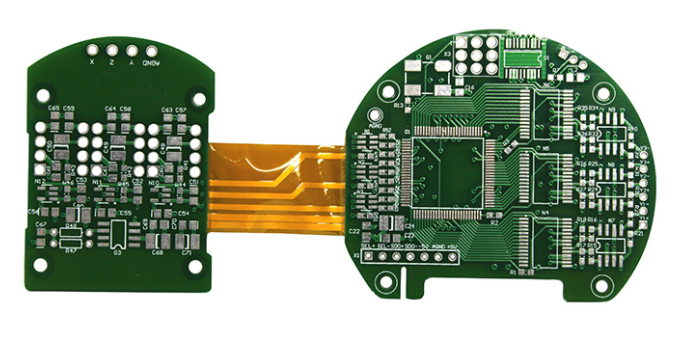Circuit board test and selection
1. Evaluation of the long-term reliability of the finished board In order to evaluate the relationship between the decrease in the Z-axis thermal expansion coefficient of the finished board and the long-term reliability of Td, researchers have compared the performance of various substrates. The four selected plates have been screened in advance to determine the range of tested data, which can indeed cover the reliability specifications of most plates on the market today, and the detailed characteristics of these four plates are shown in Table 1. First, each resin to be tested is a substrate composed of 7628 glass cloth to determine its CTE value. Multilayer boards often have different CTE values due to different combinations. The A plate is a traditional FR-4 base material with a Tg of 175°C. The other Modified A plate has the same properties as A except for the lower coefficient of thermal expansion in the Z axis. The Z axis CTE of product B is the same as that of product A, but its Td (350°C) is higher than that of product A (310°C); the Z axis CTE of product C is lower and its Td is also very high. In the above table, before Tg The Z-axis CTE is also called α-1CTE, and after Tg, it is also called α-2CTE. The results of the IST test will also be significantly different for plates with different Td. Those with a Td of 310°C cannot tolerate a thermal cycle test of more than 200 times. In contrast, for those with a Td of 350°C, the tolerable thermal cycle test has exceeded 500 times. Experimental data confirms that substrates with a smaller Z-axis have better electrical reliability, but the degree of influence is still not as obvious as those with high Td. In addition, the setting range of the experimental parameters must be expanded as much as possible to confirm that reducing the Z-axis CTE does have certain advantages, and the difference in the Z-axis CTE between the samples should also be tested. In summary, within the range of the test parameters, the preliminary results show that the material with higher Td has a greater degree of reliability improvement; as for the lower Z-axis CTE, although it does help the reliability, only the degree of improvement is Less significant. 2. Anti-CAF
The circuit board test method IST can be used to quickly evaluate the reliability of the completed multilayer board. The dense through-holes of the test board adopt the series design of Daisy Chain. The test is always designed to apply current to each through-hole synchronously. Under the action of resistance, a high temperature of 150 degree Celsius will be generated. After the power is turned off, it can return to room temperature. The cyclic IST test can replace the traditional and extremely time-consuming thermal cycle test (usually more than 168 hours). After the test, calculate how many times the test board can endure the thermal cycle test before the electrical failure 
The test board used for evaluation is a 20-layer board with a thickness of 0.105" with a through hole diameter of 0.012". The target thickness of the electroplated copper layer on the hole wall is 1.01 mil, the actual measured average thickness is about 0.7-0.8 mil, and the minimum thickness is also 0.6 mil. Generally speaking, the variation of PCB manufacturing is likely to affect this test. Therefore, the process of all samples is deliberately made the same in order to minimize the process error.
The anodic glass beam leakage phenomenon CAF has been the focus of research on substrates in recent years. When the circuit board continues to be densely assembled and approaches the distance between the through holes, and the heat of lead-free soldering increases, the CAF attracts more attention. . This article does not intend to discuss this leakage phenomenon in depth. However, recent researchers have found that if the hardener in the FR-4 substrate is abandoned if the dicyandiamide formula Dicy is abandoned, its resistance to CAF will be better than that of the substrate that still uses Dicy. Figure 4 shows the better cycle times in terms of resistance. The main reason is that Dicy is more polar, so that the water absorption is larger and faster. Product B and Product C are non-Dicy hardener substrates, and their CAF resistance is better than that of Dicy-containing product A and other similar boards. Figure 3 is a 10-layer test board made up of product C. In the test, a bias voltage of 100VDC was deliberately applied, and the average insulation resistance value of the four hole pitches was measured during high temperature and high humidity aging. Readers can clearly see that the closer the hole distance, the worse the anti-CAF ability.
Six, electrical factors
Electrical properties are other characteristics that must be considered for new substrates, especially in the high-frequency field. As mentioned in the previous article, the dielectric constant (Dk) and the dissipation factor (Df) are two important parameters. For the FR-4 substrate with improved heat resistance, fortunately, the electrical performance has not deteriorated too much. Researchers have used a complex parameter to measure Dk and Df. Table 2 uses the slat-type waveguide to measure the Dk values of substrates A, B, and C and the other two competitor plates. Table 3 shows the Df values of the above five types of plates. The substrate used in this test is composed of 2116 glass cloth with a glue content of 50% by wt.
ipcb is a high-precision, high-quality PCB manufacturer, such as: isola 370hr PCB, high-frequency PCB, high-speed PCB, ic substrate, ic test board, impedance PCB, HDI PCB, Rigid-Flex PCB, buried blind PCB, advanced PCB, microwave PCB, telfon PCB and other ipcb are good at PCB manufacturing.